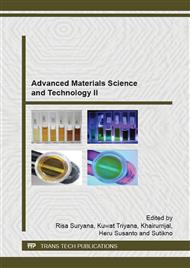[1]
P. Agarwal, P. K. Mishra, and P. Srivastava, Statistical optimization of the electrospinning process for chitosan/polylactide nano fabrication using response surface methodology, J. Mater. Sci. 47 (2012) 4262-4269.
DOI: 10.1007/s10853-012-6276-7
Google Scholar
[2]
W. Sigmund, J. Yuh, H. Park, V. Maneeratana, G. Pyrgiotakis, A. Daga, J. Taylor, J. C. Nino, Processing and structure relationships in electrospinning of ceramic fiber systems, J. Am. Ceram. Soc. 89 (2006) 395-407.
DOI: 10.1111/j.1551-2916.2005.00807.x
Google Scholar
[3]
A. Greiner, J. H. Wendorff, Electrospinning: a fascinating method for the preparation of ultrathin fibers, Angew. Chem. Int. Ed. 46 (2007) 5670-5703.
DOI: 10.1002/anie.200604646
Google Scholar
[4]
X. B. He, H. Yang, Preparation of SiC fiber-reinforced SiC composites, J. Matter. Proccess. Technol. 159 (2005) 135-138.
Google Scholar
[5]
X. H. Qin, S. Y. Wang, Filtration properties of electrospinning nanofibers, J. Appl. Polym. Sci. 102 (2006) 1285-1290.
DOI: 10.1002/app.24361
Google Scholar
[6]
S. Zhang, Y. Huang, X. Yang, F. Mei, Q. Ma, G. Chen, S. Ryu, X. Deng, Gelatin nano fibrous membrane fabricated by electrospinning of aqueous gelatin solution for guided tissue regeneration, J. Biomed. Mater. Res. 90 (2006) 671-679.
DOI: 10.1002/jbm.a.32136
Google Scholar
[7]
G. D. Sorarù, L. Pederiva, J. Latournerie, R. Raj, Pyrolysis kinetics for the conversion of a polymer into an amorphous silicon oxycarbide ceramic, J. Am. Ceram. Soc. 85 (2002) 2181-2187.
DOI: 10.1111/j.1151-2916.2002.tb00432.x
Google Scholar
[8]
C. Moysan, R. Riedel, R. Harshe, T. Rouxel, F. Augereau, Mechanical characterization of a polysiloxane-derived SiOC glass, J. Eur. Ceram. Soc. 27 (2007) 397-403.
DOI: 10.1016/j.jeurceramsoc.2006.01.016
Google Scholar
[9]
Y. L. Li, H. Fan, D. Su, C. Fasel, R. Riedel, Synthesis, structures, and properties of bulk Si (O) C ceramics from polycarbosilane, J. Am. Ceram. Soc. 92 (2009) 2175-2181.
DOI: 10.1111/j.1551-2916.2009.03184.x
Google Scholar
[10]
H. W. Tong, M. Wang, An investigation into the influence of electrospinning parameters on the diameter and alignment of poly (hydroxybutyrate‐co‐hydroxyvalerate) fibers, J. Appl. Polym. Sci. 120 (2011) 1694-1706.
DOI: 10.1002/app.33302
Google Scholar
[11]
M. Narisawa, Silicone resin applications for ceramic precursors and composites, Mater. 3 (2010) 3518-3536.
DOI: 10.3390/ma3063518
Google Scholar
[12]
A. Guo, M. Roso, M. Modesti, J. Liu, P. Colombo, Preceramic polymer‐derived SiOC fibers by electrospinning, J. Appl. Polym. Sci. 131 (2013) 39836.
DOI: 10.1002/app.39836
Google Scholar
[13]
K. Okamura, Ceramic fibers from polymer precursors, Composites 18 (1987) 107-120.
Google Scholar


